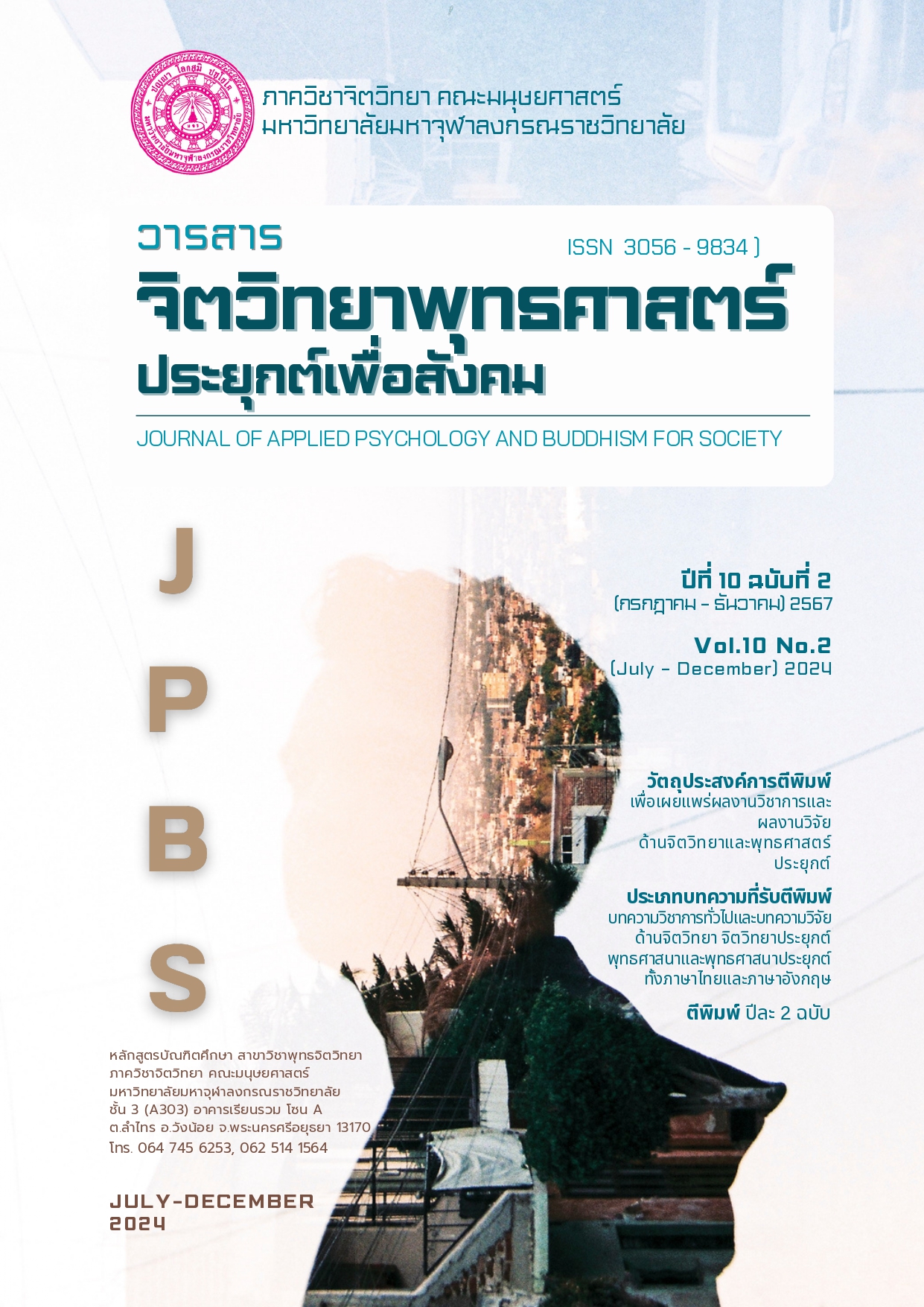Buddhist Psychology Model Promotes Happy Creative Leadership Create in Network Business Organization
Keywords:
Buddhist Psychology, Leader, Creative Leadership for Well-being, Network Business OrganizationAbstract
This research aims to: 1. analyze the principles of Buddhist teachings and psychological theories that promote creative leadership for well-being in network business organizations, 2. synthesize a Buddhist psychological model for promoting creative leadership for well-being in network business organizations, and 3. evaluate and present a Buddhist psychological model for promoting creative leadership for well-being in network business organizations. The data collection process began with a review of documents from the Tripitaka, related textbooks, and previous research. This was followed by in-depth interviews with 17 key informants, focus group discussions with 12 experts, and evaluations by 9 specialized experts. All research instruments were validated by experts and received ethical approval. The model was evaluated based on four dimensions: accuracy, appropriateness, feasibility, and usefulness. Data were analyzed using Triangulation Technique, Logical Matrix Technique, and 6'C Technique.
The findings are as follows: 1. The analysis of Buddhist principles and psychological theories for promoting leadership revealed an integration of Buddhist teachings and psychological theories. Buddhist teachings include the Threefold Training (Tri-Sikkha) and the Five Strengths (Pañca-bala), while psychological theories include Maslow's Motivation Theory and the Positive Psychology PERMA Model. These frameworks align with the development of leadership in terms of morality, well-being, and role modeling, which help build trust, motivation, happiness in organizations, and the development of network businesses and communication systems in the digital era. 2. The synthesis of a Buddhist psychological model for promoting creative leadership for well-being in network business organizations integrated three fields: Buddhist teachings, psychology, and the concept of creative leadership for well-being. This resulted in the "Buddhist Leadership Well-being Model 2MCSV," which includes five key components: mindfulness in life and business, leading by example, creating well-being within the organization, sustainability, and value creation. This model focuses on developing leaders who can create a holistic well-being across six dimensions: external well-being, internal well-being, self-well-being, well-being in collaboration with others, and well-being in work, to foster trust, motivation, and success in sustainable network business. 3. The evaluation of the Buddhist psychological model for promoting creative leadership for well-being was conducted by experts through a four-dimensional assessment system: accuracy, appropriateness, feasibility of application, and usefulness. The evaluation results showed that the model scored the highest in all areas, confirming its effectiveness and practical applicability.
References
จิรเมธ ขำสังข์. (2566). สมรรถนะผู้นำเชิงพุทธจิตวิทยาเพื่อส่งเสริมความสุขในการทำงานของวิศวกรไทย (ดุษฎีนิพนธ์พุทธศาสตรดุษฎีบัณฑิต). มหาวิทยาลัยมหาจุฬาลงกรณราชวิทยาลัย. พระนครศรีอยุธยา.
พระโกศล มณิรตนา (ญึม). (2561). รูปแบบการพัฒนาภาวะผู้นำทางการบริหารเชิงพุทธของผู้บริหารมหาวิทยาลัยมหาจุฬาลงกรณราชวิทยาลัย ภาคเหนือตอนล่าง (ดุษฎีนิพนธ์พุทธศาสตรดุษฎีบัณฑิต). มหาวิทยาลัยมหาจุฬาลงกรณราชวิทยาลัย. พระนครศรีอยุธยา.
พระใบฎีกาธีรศักดิ์ สุธีโร (น้อยอ่อน). (2565). ศึกษาการประยุกต์ใช้หลักไตรสิกขาในการส่งเสริมคุณธรรมจริยธรรม ตามแนวทางพระพุทธศาสนาเถรวาท โรงเรียนกระสังพิทยาคม ตำบลกระสัง อำเภอกระสัง จังหวัดบุรีจังหวัดบุรีรัมย์ (วิทยานิพนธ์พุทธศาสตรมหาบัณฑิต). มหาวิทยาลัยมหาจุฬาลงกรณราชวิทยาลัย. พระนครศรีอยุธยา.
พระมหาเถรานุวัตร. (2564). รูปแบบการพัฒนาภาวะผู้นำทางการบริหารเชิงพุทธของผู้บริหารมหาวิทยาลัยมหาจุฬาลงกรณราชวิทยาลัย ภาคเหนือตอนล่าง. วารสารวิจัย, 12(2), 1-15.
พระมหาสิริ์ยส สิริยโส (ชาลีเปรี่ยม). (2564). รูปแบบการบริหารจัดการการศึกษาแบบมีส่วนร่วมเชิงพุทธของโรงเรียนการกุศลในพุทธศาสนา (ดุษฎีนิพนธ์พุทธศาสตรดุษฎีบัณฑิต). มหาวิทยาลัยมหาจุฬาลงกรณราชวิทยาลัย. พระนครศรีอยุธยา.
พระราชมงคลวิเทศ (น้อม กาละสังข์). (2560). การเสริมสร้างพลังใจของชาวพุทธในสหรัฐอเมริกาตามหลักพละ 5: กรณีศึกษา วัดมงคลเทพมุนีม (วิทยานิพนธ์พุทธศาสตรมหาบัณฑิต). มหาวิทยาลัยมหาจุฬาลงกรณราชวิทยาลัย. พระนครศรีอยุธยา.
สมเด็จพระพุทธโฆษาจารย์ (ป. อ. ปยุตฺโต). (2556). ภาวะผู้นำ (พิมพ์ครั้งที่ 7). กรุงเทพฯ : สุขภาพใจ.
“________”. (2564). พุทธธรรม ฉบับปรับขยาย. กรุงเทพฯ : สหธรรมมิก.
“________”. (2565). ภาวะผู้นำ (พิมพ์ครั้งที่ 9). กรุงเทพฯ : สุขภาพใจ.
สมประวิณ มันประเสริฐ. (2565). มุมมองเศรษฐกิจปี 2022. สืบค้น 14 พฤศจิกายน 2565, จาก https://www.scb.co.th/about-us/news/jun-2565
Maslow, A. H. (1970). Motivation and personality (2nd ed.). New York: Harper & Row.
Peterson, C., & Seligman, M. E. P. (2004). Character strengths and virtues: A handbook and classification. New York: Oxford University Press.
Ross, D. (2022). Who Are We?. Retrieved November 15, 2024, from https://brandane.com/
Downloads
Published
How to Cite
Issue
Section
Categories
License
Copyright (c) 2024 Journal of Applied Psychology and Buddhism for Society

This work is licensed under a Creative Commons Attribution-NonCommercial-NoDerivatives 4.0 International License.





